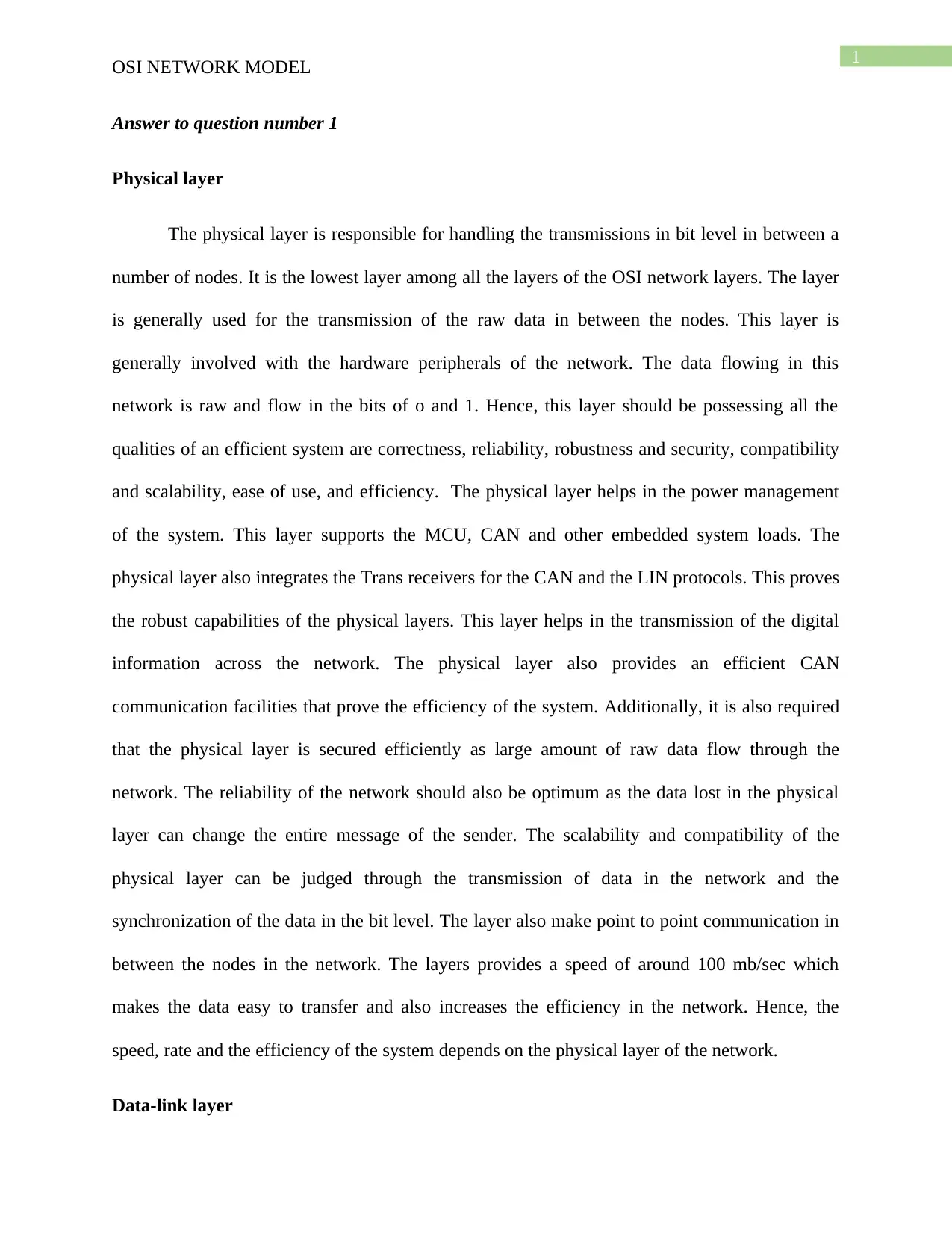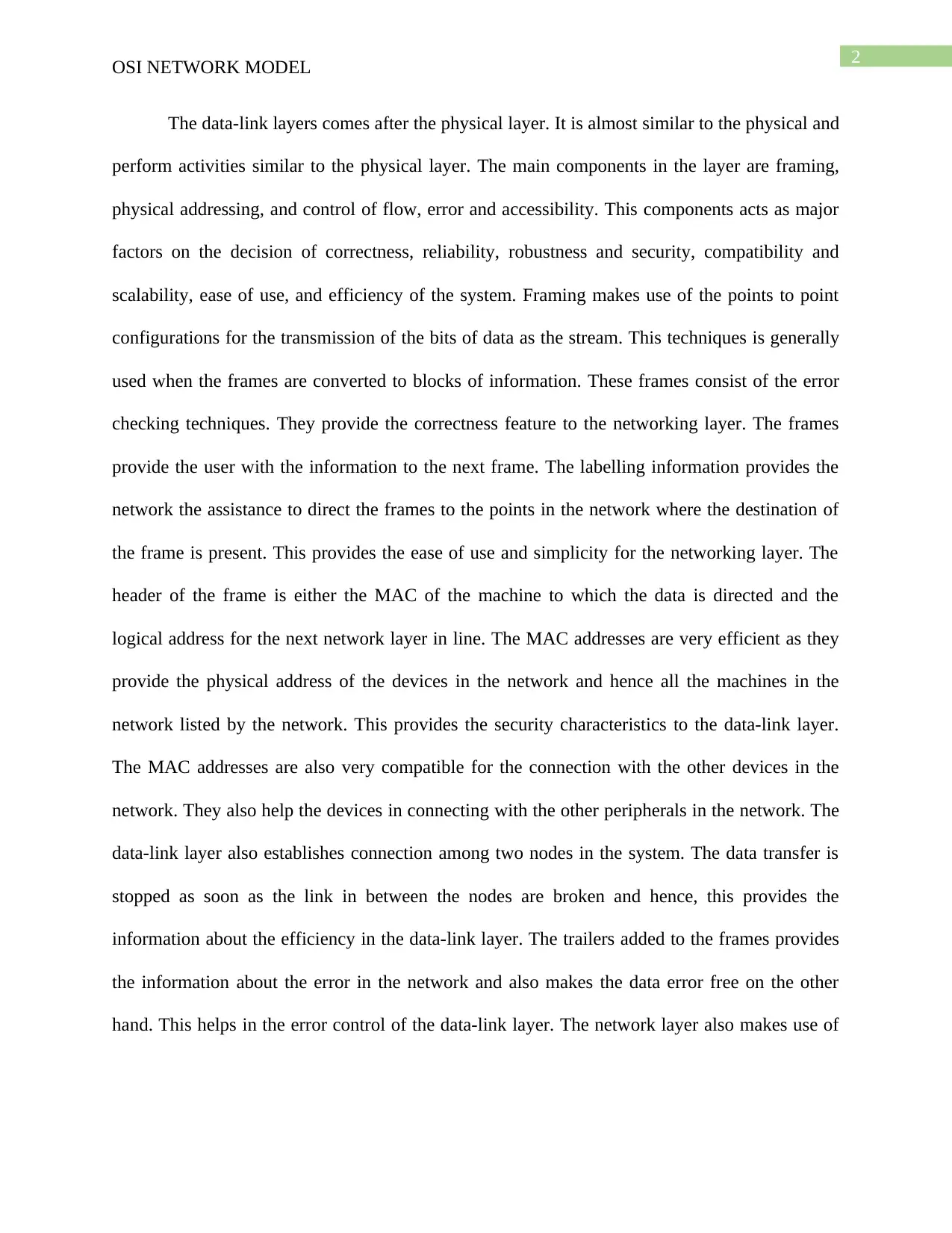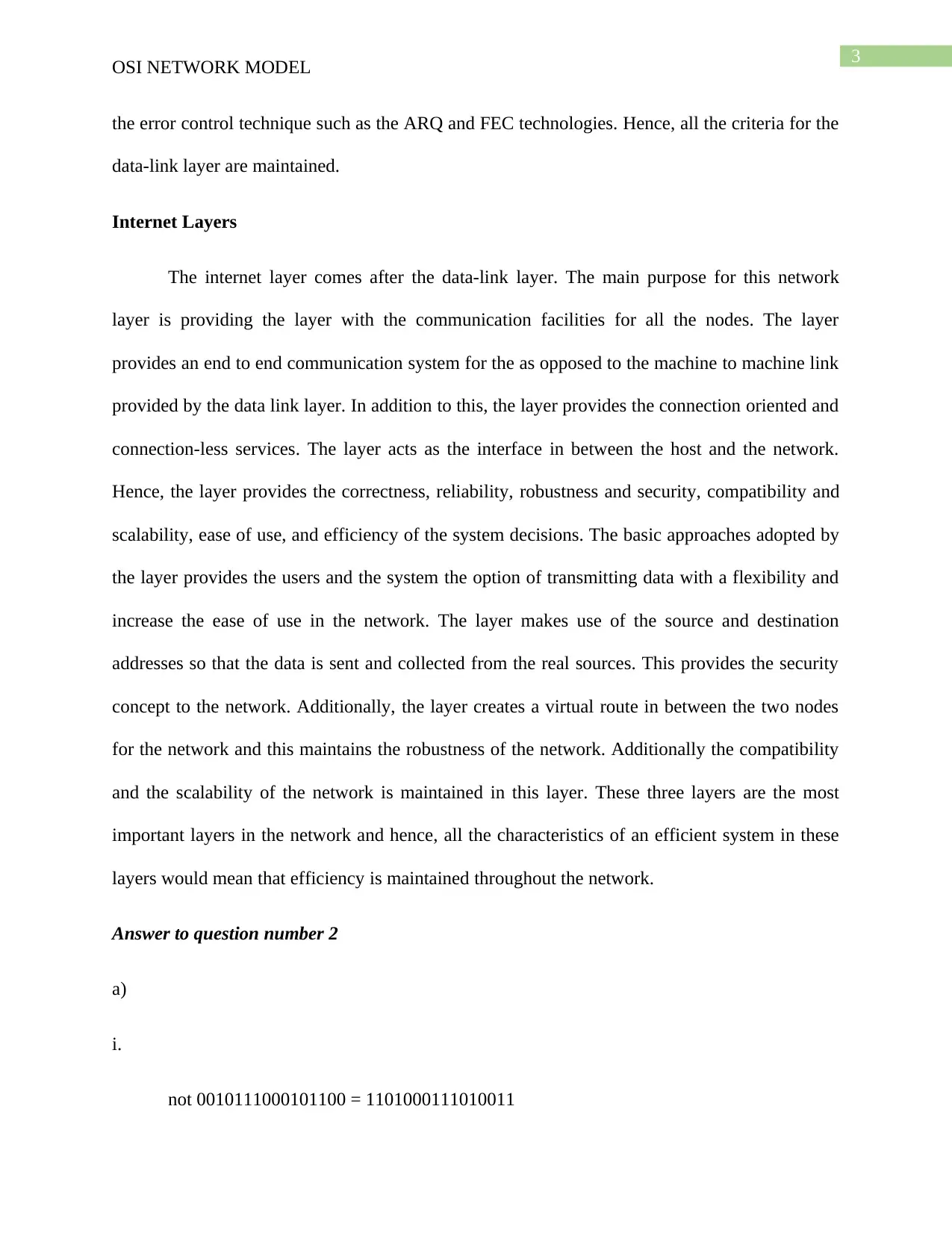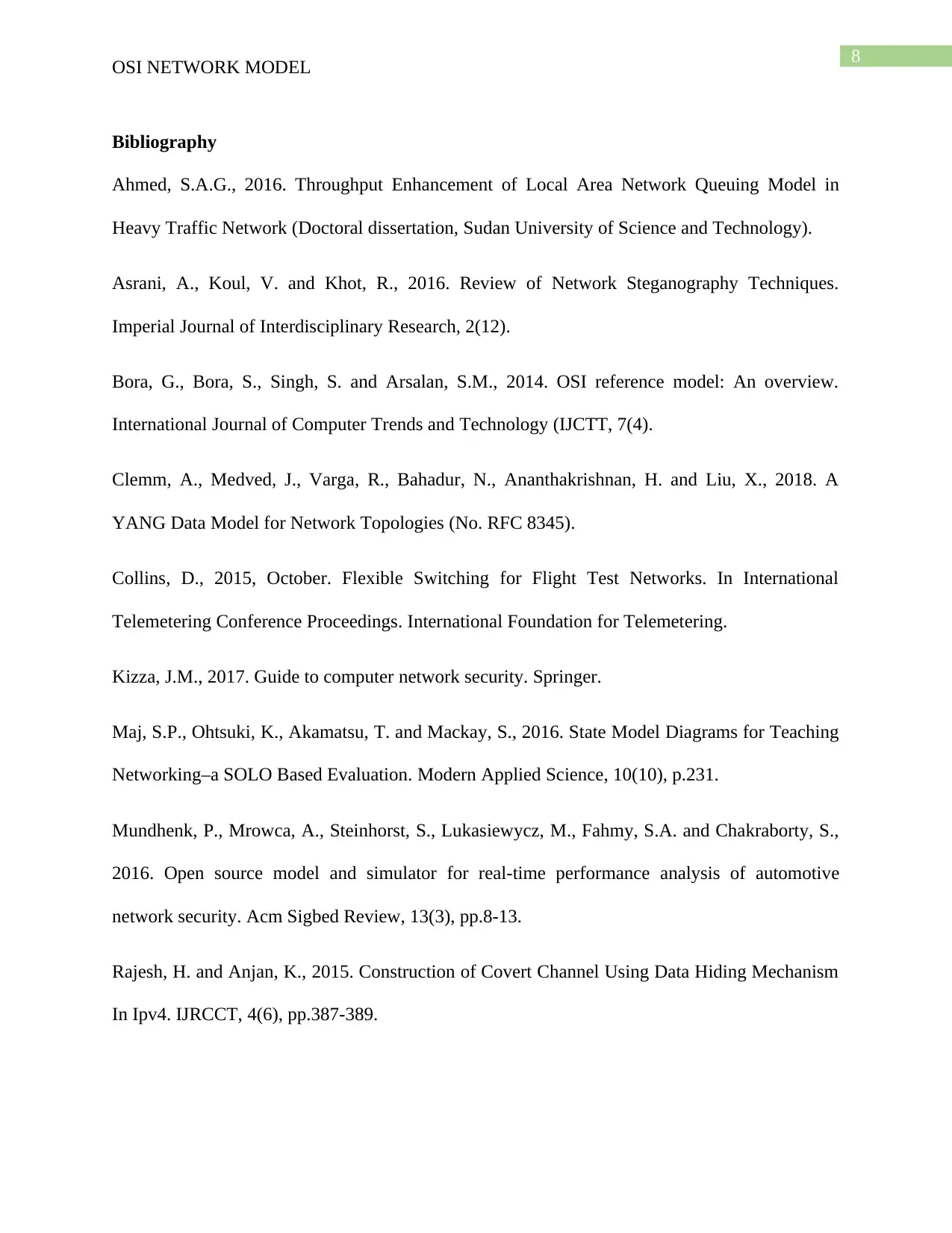Comprehensive Analysis of the OSI Network Model and Its Components
VerifiedAdded on 2021/04/20
|10
|1745
|54
Homework Assignment
AI Summary
This assignment delves into the intricacies of the OSI network model, exploring the functionalities of its various layers. The solution begins by examining the physical layer, detailing its role in bit-level transmissions and hardware interactions, along with discussions on correctness, reliability, and security. Moving up the model, the data-link layer is analyzed, focusing on framing, addressing, and error control mechanisms. The internet layer is then examined, highlighting its role in end-to-end communication and the provision of connection-oriented and connection-less services. The assignment also includes solutions to specific problems involving bitwise operations, subnet masks, and controlled versus contention-based access methods. The document concludes with a comprehensive bibliography of relevant sources.

Running head: OSI NETWORK MODEL
OSI Network Model
Name of the Student:
Name of the University:
Author Note
OSI Network Model
Name of the Student:
Name of the University:
Author Note
Paraphrase This Document
Need a fresh take? Get an instant paraphrase of this document with our AI Paraphraser

1
OSI NETWORK MODEL
Answer to question number 1
Physical layer
The physical layer is responsible for handling the transmissions in bit level in between a
number of nodes. It is the lowest layer among all the layers of the OSI network layers. The layer
is generally used for the transmission of the raw data in between the nodes. This layer is
generally involved with the hardware peripherals of the network. The data flowing in this
network is raw and flow in the bits of o and 1. Hence, this layer should be possessing all the
qualities of an efficient system are correctness, reliability, robustness and security, compatibility
and scalability, ease of use, and efficiency. The physical layer helps in the power management
of the system. This layer supports the MCU, CAN and other embedded system loads. The
physical layer also integrates the Trans receivers for the CAN and the LIN protocols. This proves
the robust capabilities of the physical layers. This layer helps in the transmission of the digital
information across the network. The physical layer also provides an efficient CAN
communication facilities that prove the efficiency of the system. Additionally, it is also required
that the physical layer is secured efficiently as large amount of raw data flow through the
network. The reliability of the network should also be optimum as the data lost in the physical
layer can change the entire message of the sender. The scalability and compatibility of the
physical layer can be judged through the transmission of data in the network and the
synchronization of the data in the bit level. The layer also make point to point communication in
between the nodes in the network. The layers provides a speed of around 100 mb/sec which
makes the data easy to transfer and also increases the efficiency in the network. Hence, the
speed, rate and the efficiency of the system depends on the physical layer of the network.
Data-link layer
OSI NETWORK MODEL
Answer to question number 1
Physical layer
The physical layer is responsible for handling the transmissions in bit level in between a
number of nodes. It is the lowest layer among all the layers of the OSI network layers. The layer
is generally used for the transmission of the raw data in between the nodes. This layer is
generally involved with the hardware peripherals of the network. The data flowing in this
network is raw and flow in the bits of o and 1. Hence, this layer should be possessing all the
qualities of an efficient system are correctness, reliability, robustness and security, compatibility
and scalability, ease of use, and efficiency. The physical layer helps in the power management
of the system. This layer supports the MCU, CAN and other embedded system loads. The
physical layer also integrates the Trans receivers for the CAN and the LIN protocols. This proves
the robust capabilities of the physical layers. This layer helps in the transmission of the digital
information across the network. The physical layer also provides an efficient CAN
communication facilities that prove the efficiency of the system. Additionally, it is also required
that the physical layer is secured efficiently as large amount of raw data flow through the
network. The reliability of the network should also be optimum as the data lost in the physical
layer can change the entire message of the sender. The scalability and compatibility of the
physical layer can be judged through the transmission of data in the network and the
synchronization of the data in the bit level. The layer also make point to point communication in
between the nodes in the network. The layers provides a speed of around 100 mb/sec which
makes the data easy to transfer and also increases the efficiency in the network. Hence, the
speed, rate and the efficiency of the system depends on the physical layer of the network.
Data-link layer

2
OSI NETWORK MODEL
The data-link layers comes after the physical layer. It is almost similar to the physical and
perform activities similar to the physical layer. The main components in the layer are framing,
physical addressing, and control of flow, error and accessibility. This components acts as major
factors on the decision of correctness, reliability, robustness and security, compatibility and
scalability, ease of use, and efficiency of the system. Framing makes use of the points to point
configurations for the transmission of the bits of data as the stream. This techniques is generally
used when the frames are converted to blocks of information. These frames consist of the error
checking techniques. They provide the correctness feature to the networking layer. The frames
provide the user with the information to the next frame. The labelling information provides the
network the assistance to direct the frames to the points in the network where the destination of
the frame is present. This provides the ease of use and simplicity for the networking layer. The
header of the frame is either the MAC of the machine to which the data is directed and the
logical address for the next network layer in line. The MAC addresses are very efficient as they
provide the physical address of the devices in the network and hence all the machines in the
network listed by the network. This provides the security characteristics to the data-link layer.
The MAC addresses are also very compatible for the connection with the other devices in the
network. They also help the devices in connecting with the other peripherals in the network. The
data-link layer also establishes connection among two nodes in the system. The data transfer is
stopped as soon as the link in between the nodes are broken and hence, this provides the
information about the efficiency in the data-link layer. The trailers added to the frames provides
the information about the error in the network and also makes the data error free on the other
hand. This helps in the error control of the data-link layer. The network layer also makes use of
OSI NETWORK MODEL
The data-link layers comes after the physical layer. It is almost similar to the physical and
perform activities similar to the physical layer. The main components in the layer are framing,
physical addressing, and control of flow, error and accessibility. This components acts as major
factors on the decision of correctness, reliability, robustness and security, compatibility and
scalability, ease of use, and efficiency of the system. Framing makes use of the points to point
configurations for the transmission of the bits of data as the stream. This techniques is generally
used when the frames are converted to blocks of information. These frames consist of the error
checking techniques. They provide the correctness feature to the networking layer. The frames
provide the user with the information to the next frame. The labelling information provides the
network the assistance to direct the frames to the points in the network where the destination of
the frame is present. This provides the ease of use and simplicity for the networking layer. The
header of the frame is either the MAC of the machine to which the data is directed and the
logical address for the next network layer in line. The MAC addresses are very efficient as they
provide the physical address of the devices in the network and hence all the machines in the
network listed by the network. This provides the security characteristics to the data-link layer.
The MAC addresses are also very compatible for the connection with the other devices in the
network. They also help the devices in connecting with the other peripherals in the network. The
data-link layer also establishes connection among two nodes in the system. The data transfer is
stopped as soon as the link in between the nodes are broken and hence, this provides the
information about the efficiency in the data-link layer. The trailers added to the frames provides
the information about the error in the network and also makes the data error free on the other
hand. This helps in the error control of the data-link layer. The network layer also makes use of
⊘ This is a preview!⊘
Do you want full access?
Subscribe today to unlock all pages.

Trusted by 1+ million students worldwide

3
OSI NETWORK MODEL
the error control technique such as the ARQ and FEC technologies. Hence, all the criteria for the
data-link layer are maintained.
Internet Layers
The internet layer comes after the data-link layer. The main purpose for this network
layer is providing the layer with the communication facilities for all the nodes. The layer
provides an end to end communication system for the as opposed to the machine to machine link
provided by the data link layer. In addition to this, the layer provides the connection oriented and
connection-less services. The layer acts as the interface in between the host and the network.
Hence, the layer provides the correctness, reliability, robustness and security, compatibility and
scalability, ease of use, and efficiency of the system decisions. The basic approaches adopted by
the layer provides the users and the system the option of transmitting data with a flexibility and
increase the ease of use in the network. The layer makes use of the source and destination
addresses so that the data is sent and collected from the real sources. This provides the security
concept to the network. Additionally, the layer creates a virtual route in between the two nodes
for the network and this maintains the robustness of the network. Additionally the compatibility
and the scalability of the network is maintained in this layer. These three layers are the most
important layers in the network and hence, all the characteristics of an efficient system in these
layers would mean that efficiency is maintained throughout the network.
Answer to question number 2
a)
i.
not 0010111000101100 = 1101000111010011
OSI NETWORK MODEL
the error control technique such as the ARQ and FEC technologies. Hence, all the criteria for the
data-link layer are maintained.
Internet Layers
The internet layer comes after the data-link layer. The main purpose for this network
layer is providing the layer with the communication facilities for all the nodes. The layer
provides an end to end communication system for the as opposed to the machine to machine link
provided by the data link layer. In addition to this, the layer provides the connection oriented and
connection-less services. The layer acts as the interface in between the host and the network.
Hence, the layer provides the correctness, reliability, robustness and security, compatibility and
scalability, ease of use, and efficiency of the system decisions. The basic approaches adopted by
the layer provides the users and the system the option of transmitting data with a flexibility and
increase the ease of use in the network. The layer makes use of the source and destination
addresses so that the data is sent and collected from the real sources. This provides the security
concept to the network. Additionally, the layer creates a virtual route in between the two nodes
for the network and this maintains the robustness of the network. Additionally the compatibility
and the scalability of the network is maintained in this layer. These three layers are the most
important layers in the network and hence, all the characteristics of an efficient system in these
layers would mean that efficiency is maintained throughout the network.
Answer to question number 2
a)
i.
not 0010111000101100 = 1101000111010011
Paraphrase This Document
Need a fresh take? Get an instant paraphrase of this document with our AI Paraphraser

4
OSI NETWORK MODEL
ii.
0010111000101100
or 1110000011100001 = 1110111011101101
iii.
0010111000101100
and 1110000011100001 = 0010000000100000
iv.
1100111000111011
and 0110111100011100 = 010011100001100
b)
i.
/8
subnet mask = 255.0.0.0
ii.
/15
Subnet mask= 255.254.0.0
iii.
/29
OSI NETWORK MODEL
ii.
0010111000101100
or 1110000011100001 = 1110111011101101
iii.
0010111000101100
and 1110000011100001 = 0010000000100000
iv.
1100111000111011
and 0110111100011100 = 010011100001100
b)
i.
/8
subnet mask = 255.0.0.0
ii.
/15
Subnet mask= 255.254.0.0
iii.
/29

5
OSI NETWORK MODEL
Subnet mask = 255.255.255.248
iv.
/19
Subnet mask= 255.255.224.0
c)
i.
255.255.248.0
Yes the address mask is legal. The slash form is /21
ii.
255.224.252.0
Yes the address mask is legal. The slash form is /22
iii.
255.255.255.224
Yes the address mask is legal. The slash form is /27
iv.
255.255.156.0
OSI NETWORK MODEL
Subnet mask = 255.255.255.248
iv.
/19
Subnet mask= 255.255.224.0
c)
i.
255.255.248.0
Yes the address mask is legal. The slash form is /21
ii.
255.224.252.0
Yes the address mask is legal. The slash form is /22
iii.
255.255.255.224
Yes the address mask is legal. The slash form is /27
iv.
255.255.156.0
⊘ This is a preview!⊘
Do you want full access?
Subscribe today to unlock all pages.

Trusted by 1+ million students worldwide

6
OSI NETWORK MODEL
No, the address mask is not legal.
d)
i.
/13
Number of hosts = 524286
ii.
/26
Number of hosts = 62
e)
In controlled access the nodes in the network consults the other nodes before sending the
informations. The administrator holds the access control for the physical locations within the
network. The clients request the server for the access to the physical content within the network.
The client can only the view the content in the network to which they are provided access to. If
the client is not provided with the access they cannot view or access the data. On the other hand
in contention based access the data is broadcasted on the network and whoever is present on the
network can access the data very easily. Any computer can transmit data at any time. However,
this gives rise to collision within the network. The data is served to the clients on a first come
first server basis and the data is available each and every node in the network.
OSI NETWORK MODEL
No, the address mask is not legal.
d)
i.
/13
Number of hosts = 524286
ii.
/26
Number of hosts = 62
e)
In controlled access the nodes in the network consults the other nodes before sending the
informations. The administrator holds the access control for the physical locations within the
network. The clients request the server for the access to the physical content within the network.
The client can only the view the content in the network to which they are provided access to. If
the client is not provided with the access they cannot view or access the data. On the other hand
in contention based access the data is broadcasted on the network and whoever is present on the
network can access the data very easily. Any computer can transmit data at any time. However,
this gives rise to collision within the network. The data is served to the clients on a first come
first server basis and the data is available each and every node in the network.
Paraphrase This Document
Need a fresh take? Get an instant paraphrase of this document with our AI Paraphraser

7
OSI NETWORK MODEL
The controlled access mechanism of getting access to physical media is known as
centralized system as the server holds all the access to the data in this network and located
centrally. Additionally, the broadcasted data is spreads all over the network and hence, this
mechanism is known as the distributed system for data access within the network. All the clients
can access the data.
OSI NETWORK MODEL
The controlled access mechanism of getting access to physical media is known as
centralized system as the server holds all the access to the data in this network and located
centrally. Additionally, the broadcasted data is spreads all over the network and hence, this
mechanism is known as the distributed system for data access within the network. All the clients
can access the data.

8
OSI NETWORK MODEL
Bibliography
Ahmed, S.A.G., 2016. Throughput Enhancement of Local Area Network Queuing Model in
Heavy Traffic Network (Doctoral dissertation, Sudan University of Science and Technology).
Asrani, A., Koul, V. and Khot, R., 2016. Review of Network Steganography Techniques.
Imperial Journal of Interdisciplinary Research, 2(12).
Bora, G., Bora, S., Singh, S. and Arsalan, S.M., 2014. OSI reference model: An overview.
International Journal of Computer Trends and Technology (IJCTT, 7(4).
Clemm, A., Medved, J., Varga, R., Bahadur, N., Ananthakrishnan, H. and Liu, X., 2018. A
YANG Data Model for Network Topologies (No. RFC 8345).
Collins, D., 2015, October. Flexible Switching for Flight Test Networks. In International
Telemetering Conference Proceedings. International Foundation for Telemetering.
Kizza, J.M., 2017. Guide to computer network security. Springer.
Maj, S.P., Ohtsuki, K., Akamatsu, T. and Mackay, S., 2016. State Model Diagrams for Teaching
Networking–a SOLO Based Evaluation. Modern Applied Science, 10(10), p.231.
Mundhenk, P., Mrowca, A., Steinhorst, S., Lukasiewycz, M., Fahmy, S.A. and Chakraborty, S.,
2016. Open source model and simulator for real-time performance analysis of automotive
network security. Acm Sigbed Review, 13(3), pp.8-13.
Rajesh, H. and Anjan, K., 2015. Construction of Covert Channel Using Data Hiding Mechanism
In Ipv4. IJRCCT, 4(6), pp.387-389.
OSI NETWORK MODEL
Bibliography
Ahmed, S.A.G., 2016. Throughput Enhancement of Local Area Network Queuing Model in
Heavy Traffic Network (Doctoral dissertation, Sudan University of Science and Technology).
Asrani, A., Koul, V. and Khot, R., 2016. Review of Network Steganography Techniques.
Imperial Journal of Interdisciplinary Research, 2(12).
Bora, G., Bora, S., Singh, S. and Arsalan, S.M., 2014. OSI reference model: An overview.
International Journal of Computer Trends and Technology (IJCTT, 7(4).
Clemm, A., Medved, J., Varga, R., Bahadur, N., Ananthakrishnan, H. and Liu, X., 2018. A
YANG Data Model for Network Topologies (No. RFC 8345).
Collins, D., 2015, October. Flexible Switching for Flight Test Networks. In International
Telemetering Conference Proceedings. International Foundation for Telemetering.
Kizza, J.M., 2017. Guide to computer network security. Springer.
Maj, S.P., Ohtsuki, K., Akamatsu, T. and Mackay, S., 2016. State Model Diagrams for Teaching
Networking–a SOLO Based Evaluation. Modern Applied Science, 10(10), p.231.
Mundhenk, P., Mrowca, A., Steinhorst, S., Lukasiewycz, M., Fahmy, S.A. and Chakraborty, S.,
2016. Open source model and simulator for real-time performance analysis of automotive
network security. Acm Sigbed Review, 13(3), pp.8-13.
Rajesh, H. and Anjan, K., 2015. Construction of Covert Channel Using Data Hiding Mechanism
In Ipv4. IJRCCT, 4(6), pp.387-389.
⊘ This is a preview!⊘
Do you want full access?
Subscribe today to unlock all pages.

Trusted by 1+ million students worldwide

9
OSI NETWORK MODEL
Santos, M.G.M. and Marcillo, P.A.A., 2018. Security in the data link layer of the OSI model on
LANs wired Cisco. Journal of Science and Research: Revista Ciencia e Investigación,
3(CITT2017), pp.106-112.
OSI NETWORK MODEL
Santos, M.G.M. and Marcillo, P.A.A., 2018. Security in the data link layer of the OSI model on
LANs wired Cisco. Journal of Science and Research: Revista Ciencia e Investigación,
3(CITT2017), pp.106-112.
1 out of 10
Related Documents
Your All-in-One AI-Powered Toolkit for Academic Success.
+13062052269
info@desklib.com
Available 24*7 on WhatsApp / Email
![[object Object]](/_next/static/media/star-bottom.7253800d.svg)
Unlock your academic potential
Copyright © 2020–2025 A2Z Services. All Rights Reserved. Developed and managed by ZUCOL.





